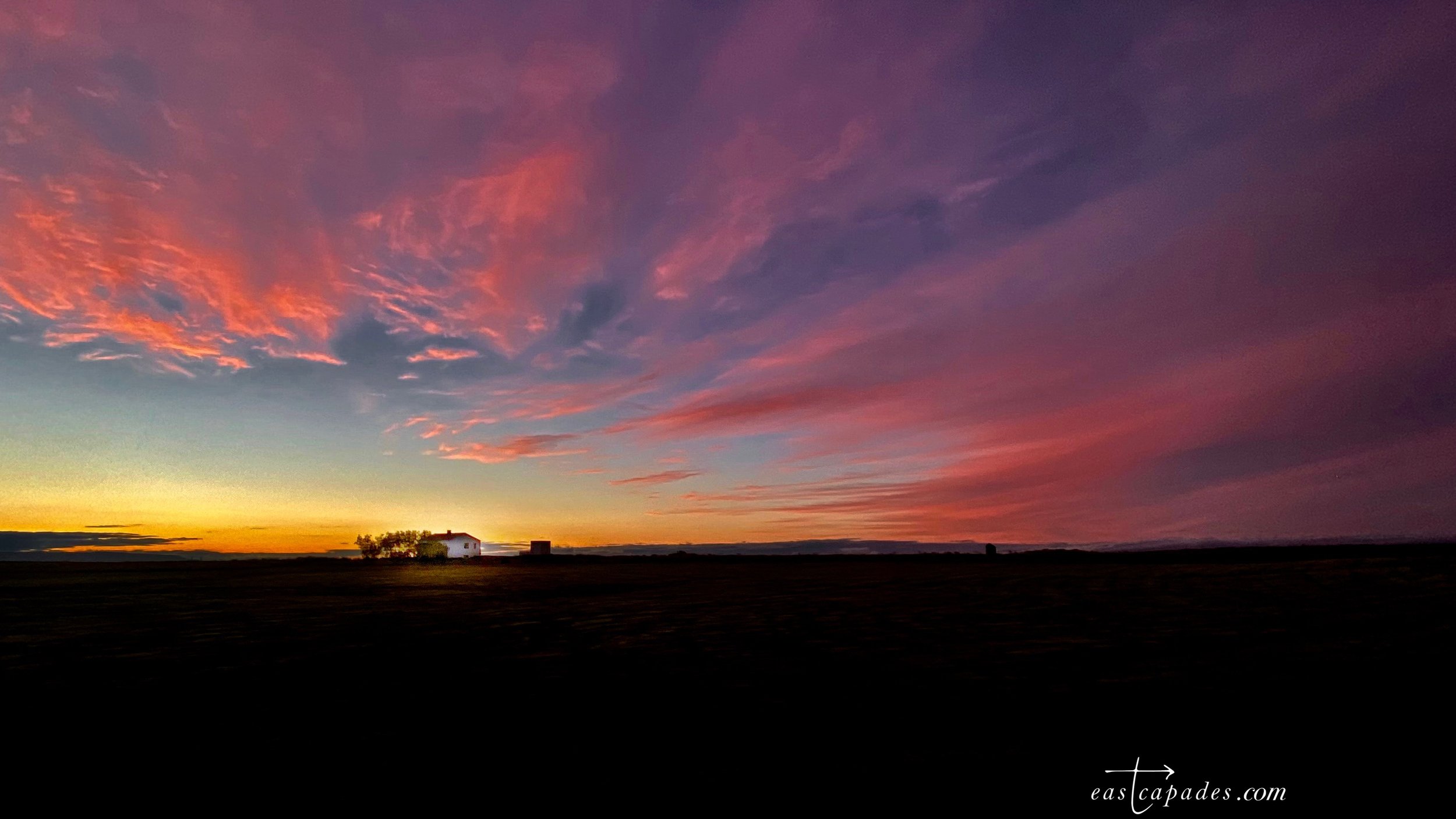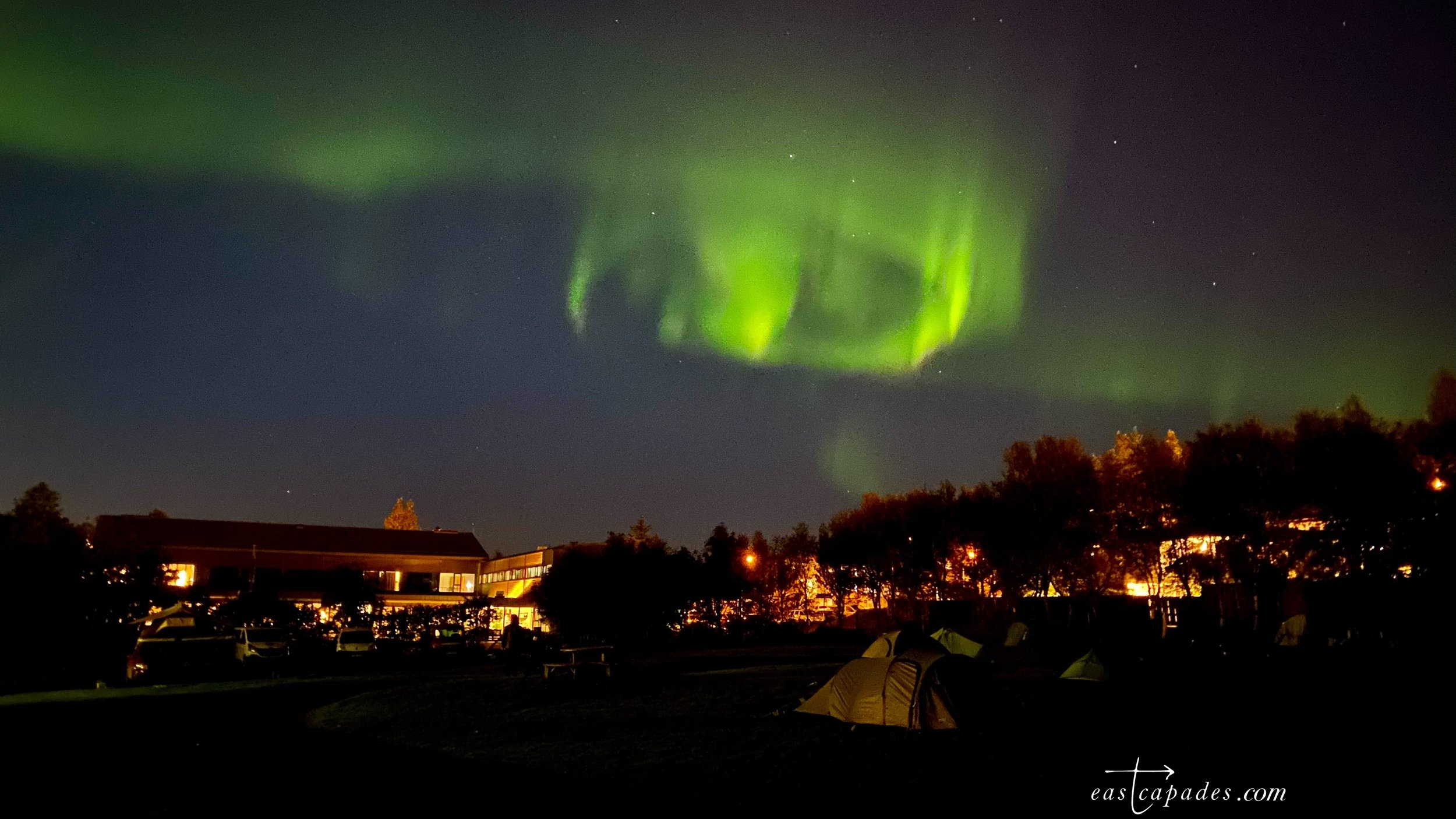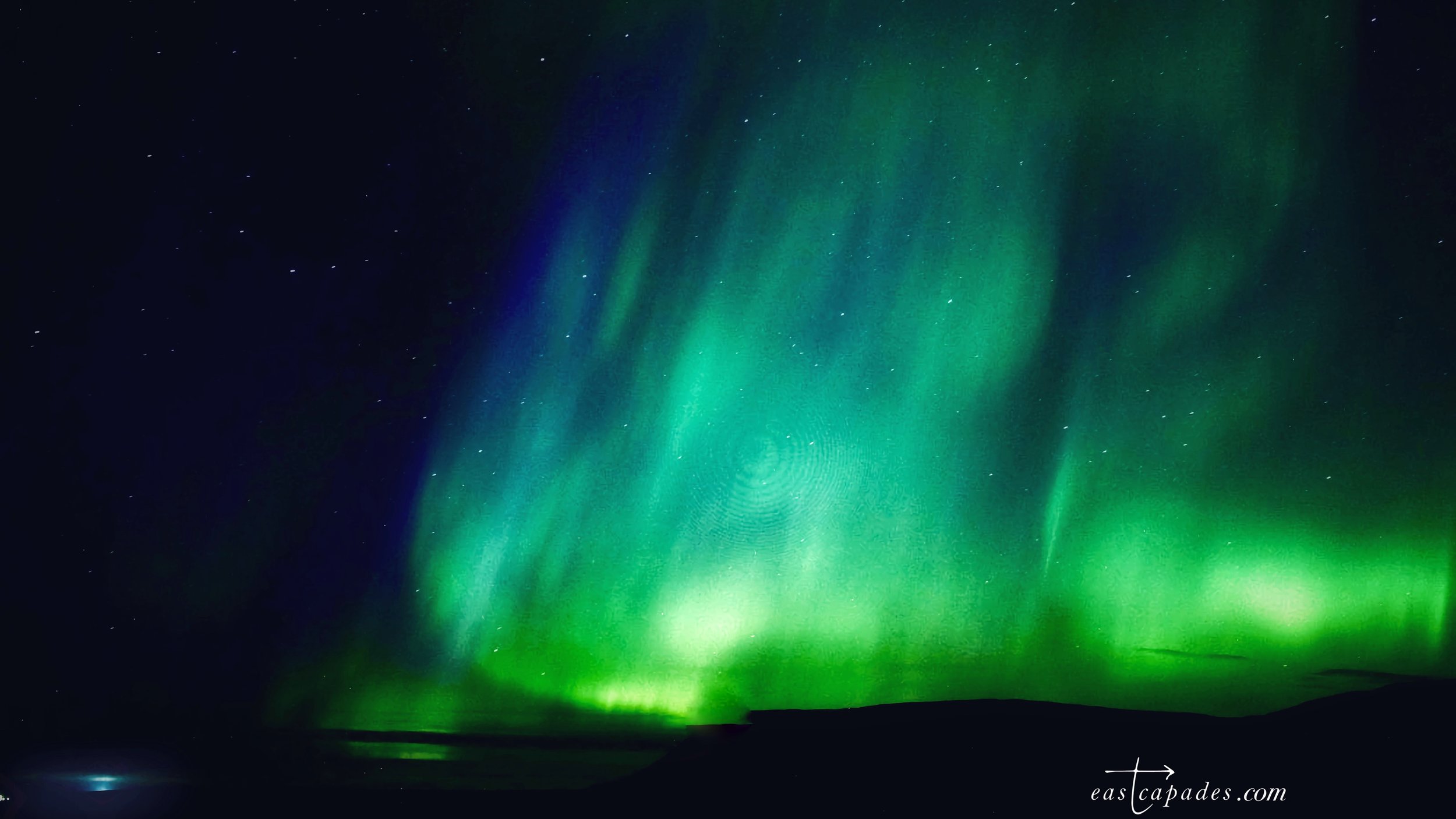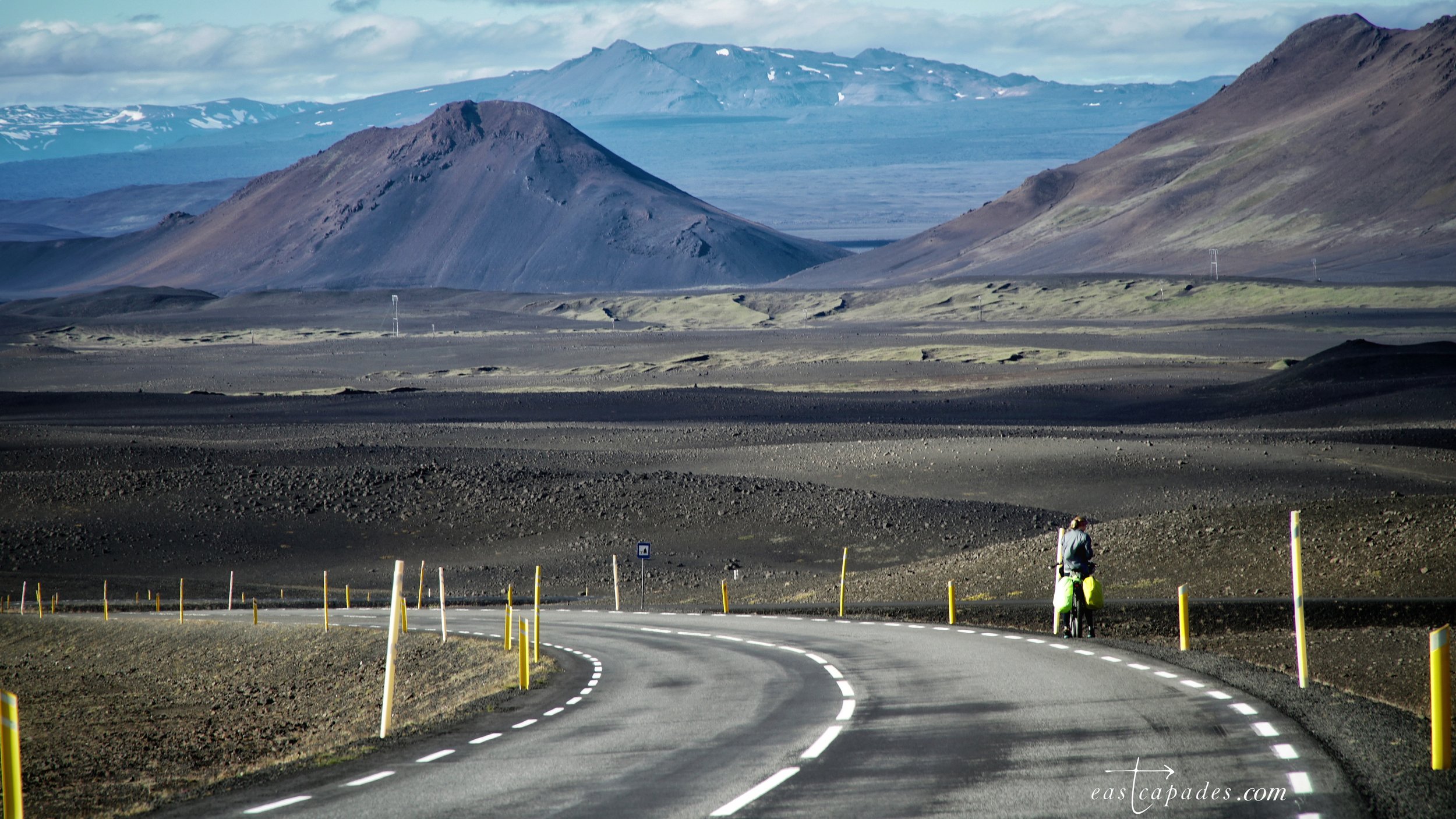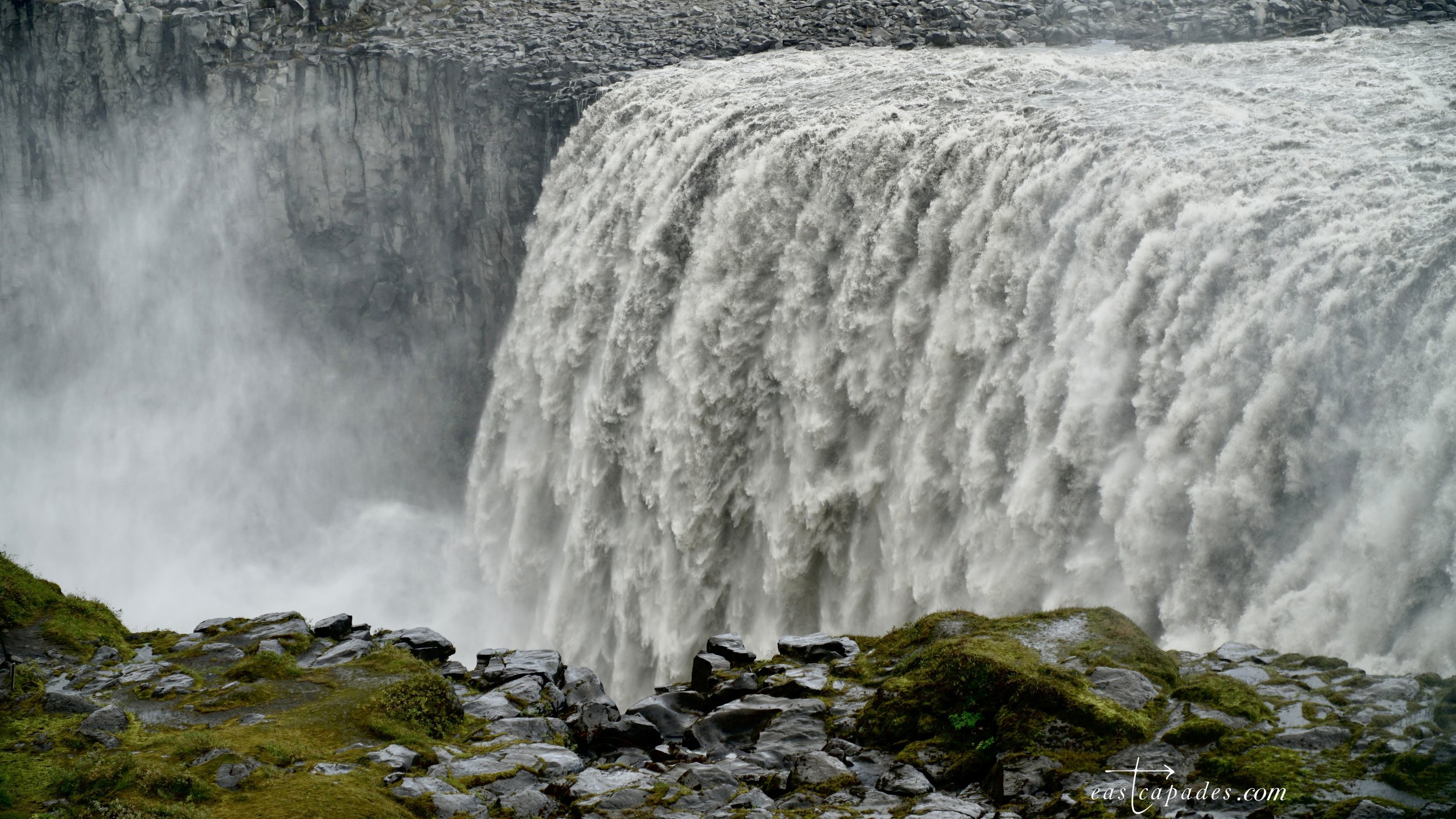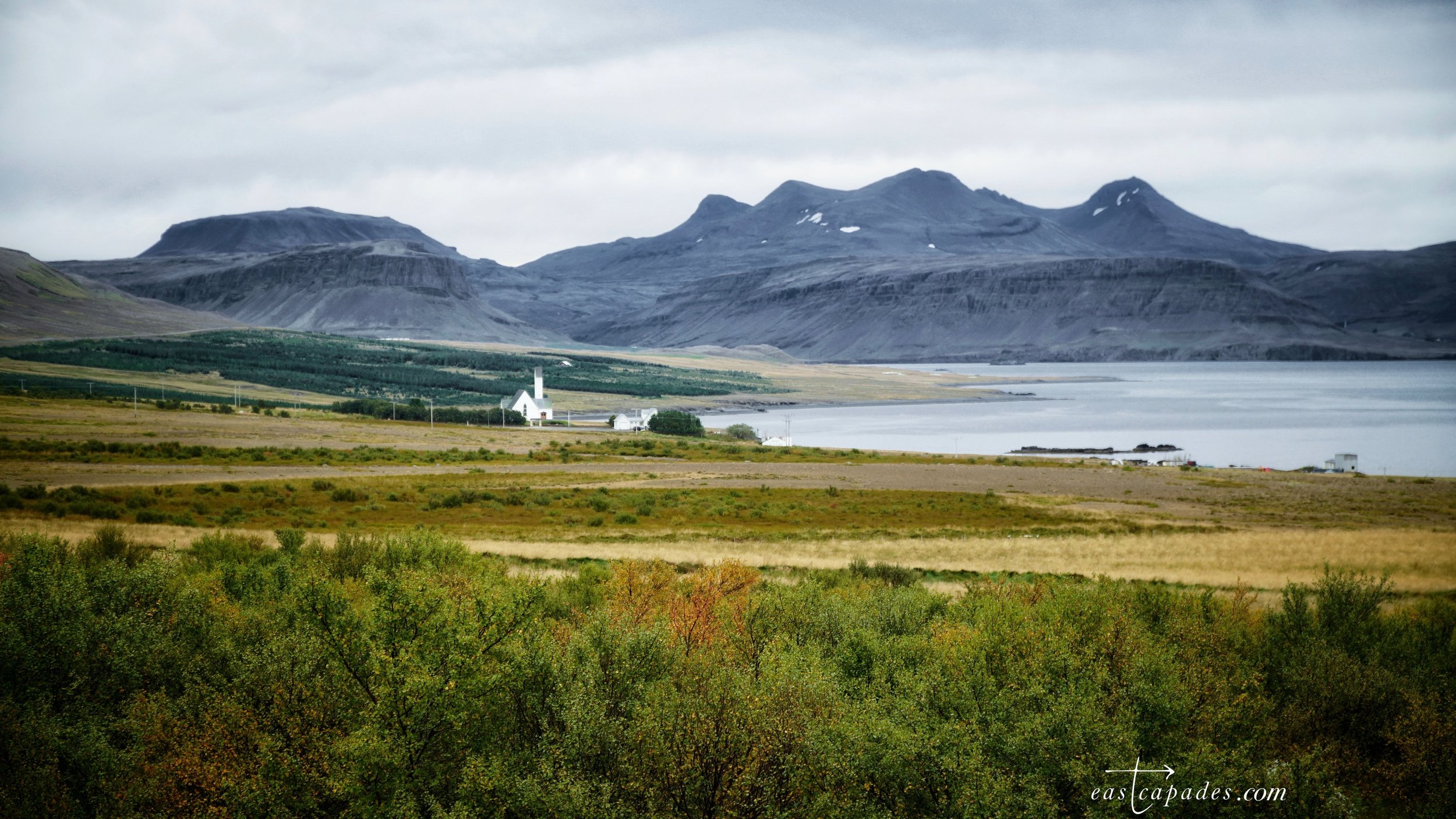challenge
+38260m/-38260m
ROUTE
4304 KM
Biking TIME
60 days
off road
182 KM
chapter 3
Denmark - Norway - Faroe - Iceland [JUne 11 - September 28 2022]
Project: Lisbon to North Cape in Norway with a return to Vancouver via the Faroe Islands and Iceland in late September.
June 11, 2022
The North part of Germany is pleasantly hilly with farm landscapes that we cross by narrow agricultural roads connecting typical German villages. We are progressing on winding paved and dirt roads surrounded by thatched roofs, low houses, and farms with cattle breeding, interspersed with drainage channels. A windy region that favours the setting of many wind farms similar to Spain and some regions of France, on the high hillsides and ridges. Even if we recognize the transitory necessity of this kind of energy production, we have to admit that they can hurt or impact the beauty of some landscapes. The relatively flat profile of the region we travel through and the annual financial contribution offered to German farmers leasing their land to electric companies have resulted in an overabundance of wind turbines. They end up being part of our daily progress but also, clearly and against all expectations, they develop in us a general physical discomfort caused by the perceptible low-frequency noise of the blades splitting the air and by their vision in un-synchronized spinning actions. Disturbing.
Denmark 🇩🇰
The crossing of the Danish border, like all the borders of the Schengen area, is only noticeable by a plate on the side of the road welcoming us while reminding us of the local rules of conduct. The side of the road reserved for cyclists is now extended by a real cycle track, most of the time paved, with directional road signs and distances between the different inhabited places. Denmark has developed a cycling network of more than 19000km (!), sometimes totally away from urban centers and any other roads. An unexpected revelation and a real pleasure during the few days spent riding through the country. Denmark is flat, so our choices are mainly based on possible tourist or cultural interests. We favour the North Sea coast. Long wild sandy beaches, and dune environments between which we remotely ride safely on bikers/walkers-only paths, each one more pleasant than the other. As if that wasn't enough to convince us that this is a country made for cycling, equipped rest areas are available for users. Benches, tables, fire pits and low wooden shelters to spend the night protected from the elements, are regularly offered along the bike track. A detailed map showing all these cycling networks and their assets allows us to plan our days accordingly with the certainty to have a sheltered night without having to pitch the tent. We only take some rare off-bike networks to reach a village and get some food. Often we hope to get a treat, find a coffee place to meet locals and socialize to find out more about Danish culture. Unfortunately, it seems that the dominantly protestant lifestyle is not encouraging social life outside of the house. It leaves us skeptical regarding human connection options and eases to build a sense of open mind towards other cultural backgrounds. As we get close to the end of our Danish experience, I remain with not much of special highlights to tell. An opinion more nuanced by Sylvia for whom flat and farm landscapes are not synonymous with visual fatigue, unlike it is for me.
Shelters for the night or just for a lunch freely accessible
Well marked bike routes allow us to progress away from traffic
Alone, on endless gravel bike paths along the coast, between dunes
Some free access shelters are beyond expectations
An old windmill, a style unseen before
At the tip North of Denmark, we camp in one of those horrible campsites reserved for residential caravans and other big RVs. The proximity of the ferry terminal, an adjoining grocery store and a long day on the saddle make the choice imperative. It is Friday and we had not anticipated that the weekend ferry schedule could be different than the weekdays’, .... the usual weekday 9 am ferry does not exist during the weekend. We must take a 4 am, much cheaper than the one at 11 am that would take us too late to Gothenburg. To take advantage of a 9 am ferry, we would have to spend the weekend in this unpleasant camping which is out of question. Despite de children's activities and the classic Friday BBQ parties, we try to get some rest in what will be a short night. We fold the tent at 2 am in the light of our headlamps and on a chilly morning, we cover the 10km ending with a superb summer sunrise on the ocean.
Thatch is used as roof covering. A long process starting with long straw
Warriors from another time
Thatched roof covering spartiate dwelling. Witness of a past life.
The 4 am ferry to Gothenburg. Cheap fares does not mean “over capacity”
Sweden 🇸🇪
The breakfast will be Swedish among smiling and friendly faces in the pedestrian area of the old district of Gothenburg. Obvious changes in behaviors are quickly noticed and we feel in better harmony with the whole first impressions of Sweden. The prices are soaring. The low-budget gustatory habits, like warm pastries along with good coffee enjoyed in the South of Europe, will need to be reviewed. The 2 nights in a basic youth hostel at the price of an airbnb in South Europe, remain the most reasonable accommodation while visiting the stress-free city. Good food, great pubs and coffee places give us a boost after the lack of them in Denmark. Every time we cross a border, we are excited and curious about what we will find beyond. It may still be the same trip stretch but for some reason, it is like closing a chapter and starting a new one.
Any small change is a source of new surprises and a new lesson to be learned. The accumulation of all these experiences opens our minds to the world and the difference between human beings. Differences are forged by the surroundings, the climate and the past. It is all about adaptation supported by a dose of resilience. It is wrong to believe one way of life prevails over others. As long as we do not visit the brain, mind, and soul of people, we can not understand them.
We follow the Swedish coast, passing from island to island. Small villages, hilly and wooded areas where farms with sheep and cattle breeding are inserted. All are in perfect harmony with small bays and sandy beaches. Peaceful progress. The omnipresence of yellow and blue colours, found on the Swedish flag reminds us of Ukraine and the struggle the country is facing. The wind encountered in Denmark is still present and the weather is more capricious as we approach Norway. Our Swedish experience is short. A rather original border crossing, marked by a white line painted on the pavement of a 2 lanes traffic bridge spanning a deep and narrow inlet, let us know that the many next weeks will be Norwegians. The road traffic in this section is exceptionally important to our great surprise. Located at the border, a huge Swedish commercial complex with hotels welcomes the Norwegians eager to buy items at good prices. We understand quickly the merits of the commercial quest as soon as we are confronted with our first purchases of groceries and other supplies. A change in cost was expected but nevertheless challenging, requiring us to adjust our next spending. We are far from the Portuguese or Spanish price level.
Feeling trapped and obliged. A Coffee stop
When family travel passions merge oddly on a crossroad somewhere in Sweden.
Norway 🇳🇴
We arrive in Oslo under buckets of water. The sky is black and threatening. Despite everything, we will be entitled to some beautiful clearings which will allow us to discover a city in full rejuvenation and renovation. Architectural audacities, and improvements of the old coastal industrial zones, are drawn and developed on a large scale while keeping the marks of a past witnessing another style of city life. The whole, keeping omnipresent the Scandinavian way of life, is forever linked to a certain quality of life and hedonism. Between cafes, restaurants and green parks, the seaside is also conducive to a social life cultivated by the well-being of body and mind. At the end of the day, while elsewhere in Europe (except in Denmark ! 😉), friendly and social meetings take place in pubs, here in Norway, saunas on floating barges anchored to pontoons or offshore serve as places of reunion and social interactivity. A simple hut on a platform, a chimney letting out a cloud of smoke with the smell of wood fire and from time to time, a door that opens giving access to the cold waters of the North Sea allowing the thermal shock sought by the amateur. The spectacular Munch museum and the new opera/concert hall are the unbeatable highlights of the new area. Small beaches, grassy spots and numerous open-sky bars are filling the gaps, making the entire stretch very pleasant for a stroll.
Oslo downtown and coast line. Sauna on barge and city in the background
We leave Oslo early in the morning. Our departure coincides with the commuters going to their workplaces. We share the cycle track, on nearly 30km, with hundreds, thousands, of commuter cyclists. A daily morning festive atmosphere. Some use this moment of the day as a moment of well-being while others transform it into a training session, sometimes racing with other regulars of the course. A real pleasure which we take part in with our loaded bikes. The more serious matters start further on when we have to leave the seaside and tackle our first Norwegian pass. A visibly important road segment with heavy traffic is fairly complicated to negotiate for us because of the road widening works. At the foot of the climb, still, at sea level, we pass the 1952 winter games Olympic jumping ramp. A surprising sight at the altitude of sea level. Further in the climb, we manage to get off traffic following a network of winter cross-country tracks gently winding up to the highest point offering a great lookout at the country we are going to cross during the next few days.
Stave churches are the oldest preserved wooden churches in Chritianity. A viking heritage of the Middle Ages
Classic grassy roofs in the Norwegian country side
Rolling South Norway with the rocky ridges in the horizon. Teasers of what is waiting for us
Our timing is now dictated by a meeting scheduled with friends in mid-July in Tromso. We will not travel further North, giving up the aim of the Cap North to privilege the much more interesting landscapes and nature in the South of the country. We booked a flight from Trondheim to Tromso and will track back South to Trondheim the skipped segment with our friends, so included, the Lofoten islands. The decision proves to be judicious. Our itinerary, far from being the most direct one between Oslo and Trondheim, allows us to cross in particular the parks of Rondane and Jotunheimen, stunning wild sceneries. High rocky faces, huge plateaux, and small weekend/vacation wood cabins with grassy roofs make our daily bike efforts. Really basic camping facilities allow us to stop over for a couple of days and hike around for deeper explorations. The countryside is vast and the route gives us opportunities for 360 degrees views. As we get closer to the Arctic Circle, the climate, suddenly, turns the whole trip very wild. The wettest summer recorded in history is coming and we have no clue it is about to happen. As higher passes reach new challenging altitudes and the distance to the Arctic Circle decreases rapidly, we are not too surprised about the low temperatures, the constant wind and the frequent rain episodes. It is expected. All these conditions give the crossed landscapes, a dramatic and sometimes fascinating character. They also tempt to forge our characters as the wet and cold are not the best blend for pleasant long cycle-touring and camping experiences. The journey becomes each time more adventurous as we, now, have to deal with the combination of weather conditions and the profile of the route or the nature of the terrain under our tires.
However, if you ask us what is the best place in Norway, our answer will be “almost everywhere”
The paved ruban and the vast nature…just for us
Norway, with only 4.5 million inhabitants, is mainly a natural outdoor experience. Nature is a gift to anyone and is well seen as such, inspiring respect. To be enjoyed at a full, the country, by law, allows and encourages wild camping. A concept that, at first sight, is exciting from an independent cycle-tourist point of view. The reality is more nuanced when we discover that roadsides give access to mossy terrains full of humidity, sometimes swamped.
From high plateaus exposed to the wind, we follow long deep valleys that bear the characteristic signs of glacial pasts. We follow tumultuous rivers, pass imposing waterfalls and cross over passes in a challenging climate that makes us almost nostalgic for the two heat waves we experienced in Spain and France. It is been said that we get used to everything, after a while. I guess the “while” has not been long enough, yet.
We arrive in Trondheim. Small pleasant city, even under the rain, in which we take 3 days of rest and comfort in our first real hotel in Norway. The comfort of a room with a buffet breakfast, lazy mornings between white bed sheets, laundry and various evening treats in local pubs help us to rejuvenate after long walking visits of the city highlights. We are rested and ready for the next part of our Norwegian journey.
We feel and are well alive.
Trying to find an original angle to avoid the classic Trondheim photography
Our flight to Tromso where we join our friends is in the early morning. Luckily, the airport, far from the city, remains open at night, which allows us to spend the night in a discreet place for free…of comfort. Friends and rain are welcoming us in Tromso. Mary and Lang arrived a couple of days earlier, have tested their bikes and gears with a 60km return ride to the North Cape. They bring back the awardee photo souvenirs of the magic spot with their bikes and… their first Norwegian reality check in regards to the climate and road profiles. However, they are still showing real, although intimidating impatience to discover the Lofoten Islands with us. Never easy to jump in the move when one party has already many thousand Kms done since April. .
Crossing bridges on the road to the Lofoten is always a bike “experience”
It is by a sunny morning that we will make our first pedal strokes. The landscapes, already very different from those crossed in the South of the country, give us a good foretaste of what will be the next 6 weeks. A smartphone application becomes our best companion as it gives us detailed weather conditions with so much timing precision that we manage to avoid a big part of the heavy rains. Only low temperatures, amplified by a constant wind, remain our daily source of concern. Some gusty period exposes us to wind around 35+km/h. The crossings of some bridges become a balance challenge. Big digital boards at the beginning of the ramps announce the wind force to avoid misery.
At the end of the day, numerous campsites on our route offer the possibility to rent a wooden hut for the night. Accommodating 4 plus with kitchen facilities and a shower, they are our refuge when the weather does not encourage sleeping in tents. Despite conditions which have nothing to do with a summer bike ride, the crossed landscapes are each time source of amazement. The Lofoten is a group of islands linked by ferries ( for some full electric!), impressive steep designed bridges or long tunnels, sometimes deep underwater, all quite intimidating at first. The options of routes through the Lofoten are not many. The main one is shared with the Euro Velo route network. It is therefore not uncommon to meet several cyclists on their way North to the North Cape. By chance, we encounter some of them already met in Denmark, and Germany a few weeks earlier.
Taking advantage of rare weather window improvements, we swap our bikes for our hiking shoes and some day hikes or sailing well-known fjords for their natural beauty. A change in our routine bike efforts.
Some cycle tourers, not too “resilient”, most of them heading North, question us about the route conditions encountered up North and hope to hear from us about great dry and warmer weather. They will have to fantasize for that much longer.
Looking for bigger spots to camp, now that we are 4. Sandy coast line and beaches are often the best options to camp North of Norway. Valley between mountains are usually damped but tempting as they, sometimes, offer more wind protection… sometimes.
As for us, going South beyond the Lofoten Islands towards Trondheim, there is not much improvement to expect either. This 2022 summer begins to be tagged as the wettest and “darkest” in history. The “inconvenient” 24 h of summer daylight disturbing nights in a tent, is a non-event under cloudy skies. We will continue to plan our route day by day, sometimes even hour by hour according to the accurate and detailed weather app. When the conditions become too severe, the numerous ferry possibilities allow us to make up time and manage the weather more easily. Ferry arrivals or departures when back to back do not let us have many choices then find odd shelters like a bus stop to avoid unreasonable high rates for few, too short, hours out of the rain and wind. An experience not always enjoyed by some of us 😇.
No shield. On a bike trip, we are moving exposed, naked and vulnerable.
Then, there are “THESE” moments… a perfect temperature, a light breeze, the warmth of the sun in a sky nicely filled with all shapes of clouds, cloud shadows adding contrasts on the profiles, a smooth pavement or a rolling dirt road, an unrolling landscape where everything harmoniously found its place, the legs finding their proper rhythm, the bike moving without any concerning noise and …sometimes the right music playlist in our earphones, the perfect solitude. All raw components are edited for a perfect IMAX experience. All stars are perfectly aligned.
The thrill along the spine and goosebumps are real, like can be, a little unexpected tear of happiness. No shame about it. We know why we are doing this. We are alive
Cozy night shelter. When options are shrinking and weather not helping
We reach Trondheim at the end of August after 6 weeks shared with Mary and Lang and almost 2 months for us on the roads of Norway tagged with the official confirmation that the summer of 2022 was the wettest and coldest recorded in Norway. Norway will however remain one of the most beautiful bike experiences of this European trip… until….
Faroe islands 🇫🇴
We land in an early morning on the Faroe. Despite stormy conditions, we can not resist to explore our first Faroe Island. The tone of the next few days is given
From Trondheim, we fly to the Faroe Islands. Another night on the ground floor at Trondheim airport before a relatively short flight to the Faroe Islands, an original destination that became an evident option because of the ferry that will take us smoothly to Iceland, 9 days later. The Faroe Islands are an archipelago of 18 islands. We choose to establish a base camp at the only real campsite available in the country and explore the different islands day by day. A well-organized bus service allows us to take the bikes to explore remote corners of some islands in more depth before returning each evening to Torshavn, the capital of the Faroe Islands where we camp. The Faroe Islands are known for their storms and strong winds. We are not disappointed. We are happy to travel with an expedition tent that had already proven itself during our trip around and in the Himalayas and Central Asia. This time again our Hilleberg tent will resist the worst while other campers will have to look for shelters following the destruction of their light tent not built to bombproof condition. The Faroe Islands are the results of volcanic origin much older than Iceland for a similar geological formation.
Tourism is not even a new industry, inexistent and for good reasons due to the isolated location. The first economy was once supported by sheep and wool. Today, the wool trade market reaches the bottom, and 95% of the local economy is fishing. After a first attempt to become independent following a referendum in 2004, the islands remain however associated with Denmark just like Greenland but have their parliament which gives them a form of sovereignty. Lost in the middle of the North Atlantic Ocean, Faroes offers a harsh life to its 52,000 inhabitants but is a wonder to explore for the rare tourists who leave Denmark for a 3-day boat trip to Iceland with their campervans and 4x4 vehicles. The trip of a lifetime for some and rightly so. Nine days are plenty to have a pretty good idea of the place.
From our camping place in Tórshavn, we witness the arrival of the Norrona ferry of the Smyril line entering the Torshavn harbour on an exceptionally sunny morning. Our boarding is done in the early afternoon. We are part of the few cyclists on board, the “good” season is long gone. At the end of the season, very few passengers are on board coming from Denmark and a handful of vehicles accompany us at the time of boarding. Sylvia is worried about the reputation of the North Atlantic and the crossing. Already under the effect of "Gravol" which should mitigate the consequences of a rough crossing, she collapses after our improvised lunch on board. For 250 Euros paid to cover the cost of a double cabin and the sailing trip, I eventually join Sylvia, deeply asleep, in the late night after an almost private acoustic concert organized in the lounge for the few passengers enjoying endless happy hours. At daybreak under a blue sky and a dominant sun not seen for weeks, the coastlines of Iceland profile at the horizons. A splendid unforgettable sight. The few passengers walk the pontoons in the morning cold, cameras are in action to record similar shots duplicating images printed forever in our minds. No photo will do justice to the spectacle offered, though.
The isolation of the archipelago could be seen as a handicap for locals. The financial support given by Denmark allows the Faroese to develop energy programs and experiments to be eventually self-sufficient energy-wise. Most of the essentials for food supplies must be imported, though but from what we experience, the needs for a good quality of life are accessible to all. Maybe, soon, the place will attract more than just a community of hardcore winter surfers….. A remote place that well deserves a visit to discover stunning nature and dramatic sceneries under moody skies.
Iceland 🇮🇸
18 degrees Celsius….
The 4 cyclists present on the ferry are the first to leave. We are very surprised by this unexpected temperature. We tell the customs officer our surprise after more than 2 months of summer with a maximum temperature of 15c. He quickly reassures us that it won't last, which doesn't affect our enthusiasm at the moment. Given the early hours of the day and the nice weather, we decide to leave the most eastern Icelandic fjord without delay. A long climb to reach a pass before going down into a valley where we spend our first Icelandic night in a busy campsite full of cyclists and motor-bikers wrapping up the tour of Iceland and getting back to Europe's mainland with the ferry leaving the next morning.
In 2016, with a group of friends, we biked a part of the highlands, this time and despite our late seasonal visit in these latitudes, we headed to the Northern Arctic coast.
Iceland has shared with Scandinavian countries, a historically wet and cold summer unlike South of Europe struggling with unprecedented and endless heat waves. Expectations are none regarding the weather. We always thought that ending our journey in Iceland in September was not a great idea, but rather a nice finish with forgiven weather before Home Sweet Home. The last 3 months, anyway, have prepared us for resilience. Quickly, it seems that the wind will remain a daily cause of struggle until the end of this trip. The hours of light are rapidly decreasing each day in these latitudes and the signs of the approaching winter are more visible every day. The nights, as well as the days, become much colder and frost is not rare on the tent when we wake up. We travel long distances without any traffic. A feeling of real solitude that makes us feel ridiculously small in these lunar landscapes and endless horizons. The low temperatures which are amplified by gales, force us to limit our stops to the strictest necessary, a snack, a photo, or a quick glance at the digital map. The few vehicles we come across are found again in the evening at the camp or in the few geological sights requiring access on foot. Opportunities to meet people and start friendly relationships with some already met in the Faroe Islands. The world is not necessarily getting smaller but road options do.
It is the time when the flocks of sheep are gathered after a summer of wandering. On horseback, motorcycle or jeep, volunteers join the owners and shepherds in what has become a social and festive moment in Icelandic life.
The longer nights offer us the opportunity to watch the ballet of the Northern Lights before we return to our warm comforters in the tent. The northern part of the circular route is very wild, the possibilities of provisioning are few as well as the options of dry and cozy lodging, shelter far from the permanent noise of the wind.
The season is clearly over, even the farms offering camping possibilities are closing. Arrived at the city of Akureyri, we spend 2 nights of rest in the local youth hostel. An earthquake felt in the middle of the night reminds us of the origin of Iceland. The tiredness of the climatic conditions of these last 3 months added to the lack of supplies closed for the season have slowly a toll on our desire to stay much longer on the road. Locals are switching to hibernation mode, making us reconsider our ambitions concerning the Westfjords. We decide on a more direct route to Reykjavik that we will reach 3 days in advance of the initial plan. The occasion to celebrate the conclusion of 6 months allowed us to cross a great variety of landscapes, climates and a new richness of discovery at the same time cultural and historical scenes. As always, the decision to end a long wandering is facilitated by the return to Vancouver which is a place of inescapable resources and a necessary landing spot to plan other projects. Each idea and project maintains the flame burning to discover, to learn more and more, associated with the need to move and to feel more alive than ever.
On a bike, whether you’re on the tarmac or bumbling across the tundra, you move at the pace of the land and at the pace allowed by the weather conditions: fast enough to appreciate the change around you, slow enough to marvel at the detail of a landscape and anything that composes its originality.
These bike long journeys teach us that, for the worse or for what may feel desperate situations, often something great happens. No need to be scared by them.
A safe place found in a dire straits situation, the encounter of a person willing to be of any help/support, will eventually introduce us to new unknown territories and experiences…all leading to an unexpected path that will last in our mind much longer than the original trouble. A path that may even transform an original plan into an exceptional experience.
Never lost, just repeatedly found.
Lost and found….until next wandering
